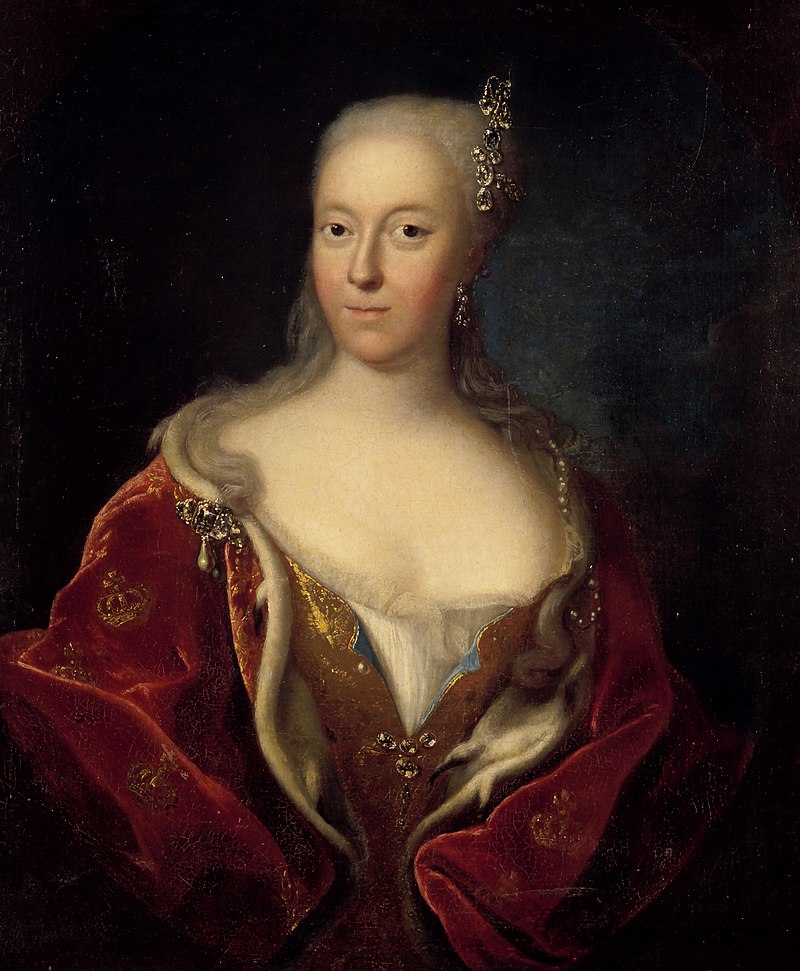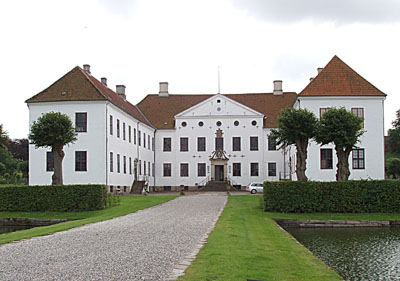by Susan Flantzer © Unofficial Royalty 2020

Anna Sophie von Reventlow, Queen of Denmark and Norway; Credit – Wikipedia
From 1711 – 1712, Anna Sophie von Reventlow was the mistress of Frederik IV, King of Denmark and Norway. From 1712 – 1721, she was the bigamous wife of Frederik IV, and then she was Queen of Denmark and Norway from 1721 until 1730 when she was expelled from the Danish court by Frederik IV’s son and successor Christian VI, King of Denmark and Norway.

Clausholm Castle, Anna Sophie’s family home; Credit – By Nico at the Danish language Wikipedia, CC BY-SA 3.0, https://commons.wikimedia.org/w/index.php?curid=6672277
Anna Sophie von Reventlow was born on April 16, 1693, at Clausholm Castle, her family home, in the eastern part of the Jutland Peninsula of Denmark. She was one of the ten children of Conrad von Reventlow, Count Reventlow of Clausholm and his second wife Sophie Amalie von Hahn. Anna Sophia had seven elder half-siblings from her father’s first marriage to Anna Margarete von Gabel. Conrad von Reventlow, Count Reventlow of Clausholm served Frederik IV, King of Denmark and Norway as Grand Chancellor, the highest-ranking non-monarchial government official at that time, similar to a Prime Minister. Nothing is known about Anna Sophie’s childhood but it is assumed that she was not well educated because her letters show that she wrote poorly in Danish, French, and German.
Among Anna Sophie’s siblings were:
Notable half-siblings from her father’s first marriage:
- Christian Detlev von Reventlow, Count Reventlow of Clausholm (1671 – 1738), was a Danish military leader and Royal President of the city of Altona, married Benedikte Margrethe von Brockdorff and had eleven children
- Christine Sophie von Reventlow (1672 – 1757), was an influential advisor to her sister Anna Sophie and brother-in-law King Frederik IV, married (1) Count Niels Friis, had one son (2) Count Ulrik Adolf von Holstein of Holsteinsborg, no children
Anna Sophie’s notable full siblings:
- Anna Margrethe (1682 – 1710), married Hans Schack, 2nd Count of Schackenborg, had four children
- Ulrikke Eleonor (1690 – 1754), married Ferdinand Anton Gyldenløve, a grandson of Frederik III, King of Denmark and Norway by his mistress Margrethe Pape, had two sons

Frederik IV, King of Denmark and Norway; Credit – Wikipedia
In 1695, Frederik IV, King of Denmark and Norway had married Louise of Mecklenburg-Güstrow with whom he had five children although three sons died in infancy. Frederik began a relationship with Elisabeth Helene von Vieregg, a lady-in-waiting to his unmarried sister Princess Sophia Hedwig of Denmark and Norway in 1699. In 1703, without divorcing his wife Queen Louise, Frederik made a bigamous marriage to Elisabeth. After Elisabeth died in 1704 due to childbirth complications giving birth to a son Frederik Gyldenløve, Frederik IV gave her an elaborate funeral. Little Frederik Gyldenløve lived for only nine months.
After the death of Elisabeth, Frederik began an affair with her lady-in-waiting, Charlotte Helene von Schindel (scroll down in the article). In 1709, Frederik wanted to again make a bigamous marriage but received strong opposition from the church which told him that the law against bigamy also applied to kings. Charlotte and Frederik had a daughter in 1710 who died in infancy.
After losing interest in his mistress Charlotte Helene von Schindel in 1711, Frederik IV then fell in love with 19-year-old Anna Sophie after meeting her at a masked ball. In 1712, Frederik abducted Anna Sophie from her parents’ home Clausholm Castle and took her to Skanderborg Castle where they were married bigamously as Frederik’s wife Queen Louise was still alive. Frederik IV installed Anna Sophie in a house on Bag Børsen (present-day Slotsholmsgade 8), close to Copenhagen Castle in Copenhagen and she was given the title Duchess of Schleswig. In 1713, Frederik gave Vallø Castle to Anna Sophie.

Vallø Castle; Credit – By Flemming – DSC_0125, CC BY-SA 2.0, https://commons.wikimedia.org/w/index.php?curid=17230727
Anna Sophie’s mother, by then a widow, did not support her daughter’s bigamous marriage, and mother and daughter did not reconcile until 1718. Anna Sophie did, however, receive support from her influential half-sister Christine Sophie who often visited her. Frederik IV preferred to spend time with Anna Sophie instead of Queen Louise and so Anna Sophie’s home became more or less a court, with gatherings of the nobility who were seeking Frederik IV’s favor. Because Frederik IV did not wish to be so public about his bigamous marriage to Anna Sophie, she was regarded by many as just his official mistress.
Queen Louise died on March 15, 1721, aged 53, and was buried at Roskilde Cathedral, the traditional burial site of the Danish royal family, in Roskilde, Denmark. On April 4, 1721, Frederik IV and Anna Sophie were married in a second formal wedding conducted with great ceremony. Although the marriage was still scandalous, it was not declared morganatic and Anna Sophie was crowned as Queen of Denmark and Norway at Frederiksberg Palace in May 1721. Neither of the two surviving children of Frederik IV and his first wife, Crown Prince Christian (future King Christian VI) nor the unmarried Princess Charlotte Amalie, kissed her hand as required by the ceremony.
Anna Sophie as Queen of Denmark and Norway, circa 1730; Credit – Wikipedia
Although Crown Prince Christian behaved with respect towards Anna Sophie, he detested her and blamed her for his father’s ill-treatment of his mother. Princess Charlotte Amalie overcame her disapproval of Anna Sophie and eventually came to like her. In 1725, King Frederik IV made an addition to his will that guaranteed Anna Sophie’s rights as Queen Dowager after his death and made Crown Prince Christian sign it.
After Anna Sophie’s coronation, Frederik IV dismissed several officials and replaced them with relatives of Anna Sophie who were known as the Reventlowske Bande (Reventlow Gang). Anna Sophie was accused of nepotism but it is not known whether she used political influence or if Frederik IV wished to strengthen her role at court by appointing those loyal to her to powerful positions.
Anna Sophie enjoyed the theater and founded, and then supported, the Lille Grønnegade Theater, the first public theater in Denmark. She was known to be generous to those in need, both privately and publically, and came to be called “The Protector of the Poor.” In 1729, Anna Sophie created the charity Dronning Anna Sofies Stiftelse (Foundation of Queen Anna Sophie) to benefit the poor.
Anna Sophie and King Frederik IV had six children. Three were born before the legal marriage in 1721 but none survived. The three children born after the 1721 marriage were styled as Prince/Princess of Denmark and Norway but none of them survived infancy either. The deaths of all the children of Frederik IV and Anna Sophie were seen by many as divine punishment for their bigamous marriage.
- Frederika Sophie von Reventlow (born and died before1721), died in infancy
- Frederica Conradine von Reventlow (born and before 1721), died in infancy
- Stillborn (before 1721)
- Princess Christiana Amalia (1723 – 1724), died in infancy
- Prince Frederik Christian (1726 – 1727), died in infancy
- Prince Karl (1728 – 1729), died in infancy
Frederik IV, King of Denmark and Norway died on October 12, 1730, the day after his 59th birthday, and was buried at Roskilde Cathedral, the traditional burial place for the Danish royal family, in a tomb adjacent to the tomb of his first wife Queen Louise. Frederik IV’s son, Christian VI, King of Denmark and Norway, did not follow the instruction in his father’s will to guarantee Anna Sophie’s rights as Queen Dowager. Christian VI’s opinion was that Anna Sophie had taken advantage of his father during his ill health and that she had caused his family pain and suffering during the years of her open adultery.
Christian VI granted Anna Sophie an allowance but confiscated all her property, and banished her to Clausholm Castle, her family home. She was allowed to be styled Queen Anna Sophie but not Queen Anna Sophie of Denmark and Norway or Queen Dowager. Anna Sophie spent the remainder of her life under house arrest at Clausholm Castle and was never granted permission to leave. She spent her time developing the gardens at Clausholm Castle, engaging in charitable works for the peasants on the estate, and in religious devotions.
When Anna Sophie, aged 49, died at Clausholm Castle on January 7, 1743, Christian VI allowed her to be buried at Roskilde Cathedral, but in the Trolle Chapel which is on the opposite side of the cathedral, far away from his parents’ tombs in the chancel of the cathedral. Her three children, born after her 1721 marriage, were also re-buried in the Trolle Chapel on Christian VI’s orders.

Tombs of Anna Sophie and three of her children; Credit – By FaceMePLS – originally posted to Flickr as Roskilde cathedral, CC BY 2.0, https://commons.wikimedia.org/w/index.php?curid=6821429
This article is the intellectual property of Unofficial Royalty and is NOT TO BE COPIED, EDITED, OR POSTED IN ANY FORM ON ANOTHER WEBSITE under any circumstances. It is permissible to use a link that directs to Unofficial Royalty.
Kingdom of Denmark Resources at Unofficial Royalty
- Kingdom of Denmark Index
- Danish Orders and Honours
- Danish Royal Burial Sites: House of Oldenburg, 1448 – 1863
- Danish Royal Burial Sites: House of Schleswig-Holstein-Sonderburg-Glücksburg, 1863 – present
- Danish Royal Christenings
- Danish Royal Dates
- Danish Royal Residences
- Danish Royal Weddings
- Line of Succession to the Danish Throne
- Profiles of the Danish Royal Family
Works Cited
- Da.wikipedia.org. 2020. Anna Sophie Reventlow. [online] Available at: <https://da.wikipedia.org/wiki/Anna_Sophie_Reventlow> [Accessed 1 May 2020].
- En.wikipedia.org. 2020. Anne Sophie Reventlow. [online] Available at: <https://en.wikipedia.org/wiki/Anne_Sophie_Reventlow> [Accessed 1 May 2020].
- En.wikipedia.org. 2020. Conrad Von Reventlow. [online] Available at: <https://en.wikipedia.org/wiki/Conrad_von_Reventlow> [Accessed 1 May 2020].
- Flantzer, Susan., 2020. Frederik IV, King Of Denmark And Norway. [online] Unofficial Royalty. Available at: <https://www.unofficialroyalty.com/frederik-iv-king-of-denmark-and-norway/> [Accessed 1 May 2020].
